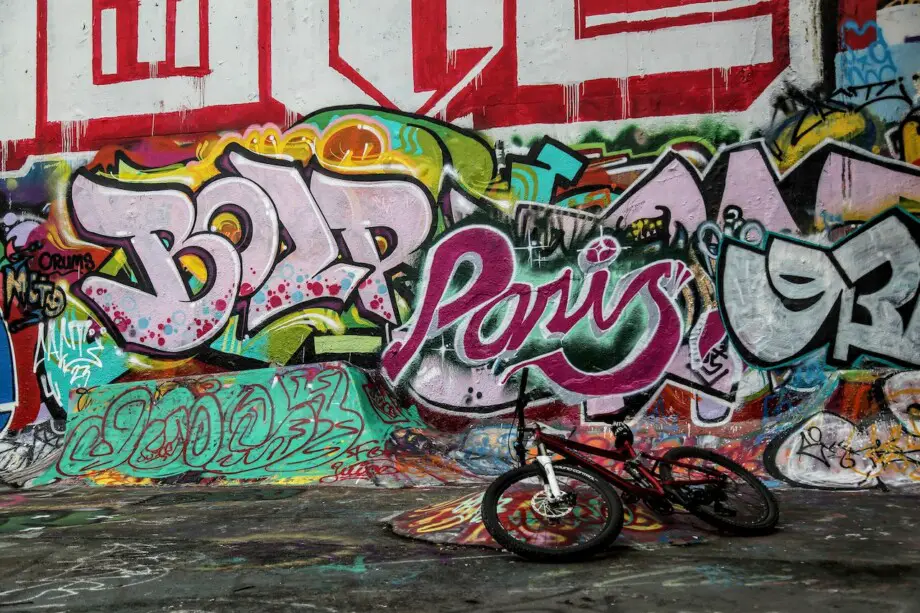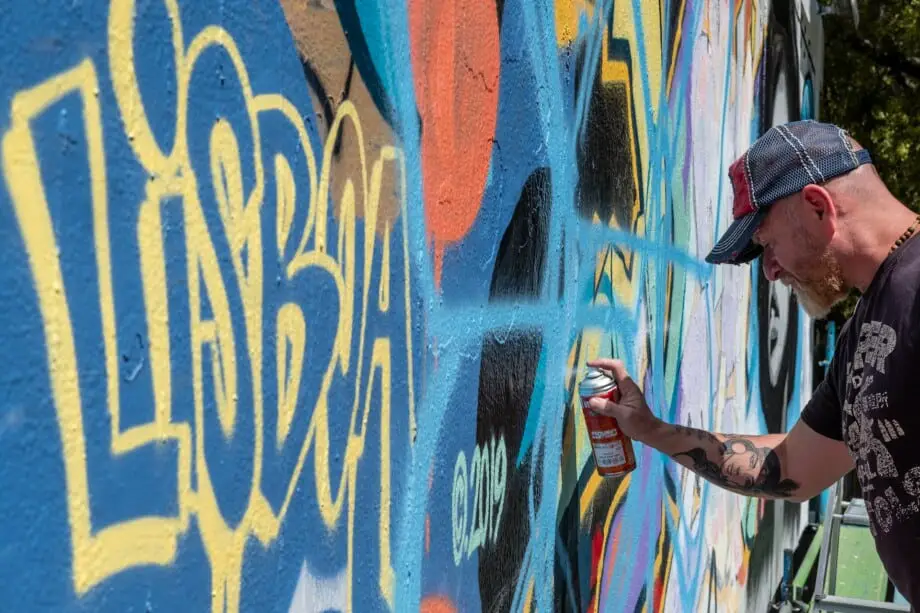Spray paint is known for providing artistic expression with its intricate designs and vibrant colors, which is a significant reason graffiti is found everywhere in Texas. Whether you’re in Dallas, Houston, or nearby small towns, you’ll witness the magic of spray paint on walls, trees, and fences.
While the colorful drawings, markings, and inscriptions may appear art to some people, many arguments also claim it as a sort of public nuisance. Nonetheless, we must consider the basic code of conduct and follow the law.
Texas law states that defacing another’s property without permission is a crime and punishable under section 28.08 of the Texas Penal Code.
The codified law in Texas outlines the severe repercussions for individuals caught vandalizing public or private property, as well as those found in possession of and misusing spray paint in public areas. The primary objective of this legislation is to deter the destruction of public and private property, as well as the misuse of spray paint.
Additionally, Texas spray paint laws prohibit minors from possessing spray paint, and retailers are strictly prohibited from selling it. These measures are in place to ensure the safety and preservation of public and private property, and to promote responsible use of spray paint.
In other states like California and Virginia, manufacturers are legally bound to label instructions on spray paint packaging, and retailers are supposed to keep them behind locked cabinets to avoid theft.
Why Implement Spray Painting Laws in Texas
Spray paints are often used for more than just art purposes, and according to Texas Penal Code, any unauthorized use of spray paint will face legal consequences, which include expensive fines, serving jail time, or contribution to community centers. Just like other states of the USA, Texas also discourage the misuse of spray paints and implements law for the following reasons.
- Vandalism and graffiti are serious offenses that are regarding defacing public and private properties without the owner’s or state’s consent, respectively. By enforcing spray paint laws, Texas can prevent Vandalism across the state.
- Spray paints are composed of hazardous substances like VOC (Volatile Organic Compound) that contribute to severe respiratory problems. To control the spread of toxic fumes, Texas state finds it essential to implement spray painting laws.
- Property owners face irreparable loss due to unauthorized graffiti, which results in devaluing their property value. By implementing spray paint laws in Texas, the state can secure proper owners from such crises.
- The majority of incidents of vandalism and graffiti are caused by gangs as the sign of their territory, which not only harms the ethical environment but represents unlawful assemblies. This gives another reason to implement spray paint laws.
PS: You can check out our blog on how to clear lungs of spray paint and how to avoid cancer from it
Texas Spray Painting Laws
Under section 28.08 of the Texas Penal Code, graffiti is defined as,
An act of marking, including paintings, drawings, and inscriptions, on the tangible property of others without effective consent. Moreover, such acts be done by means of markers, paints, and spray paints to cause intentional damage. No matter if it’s a creative art, political slogan, or protest, it will be considered illegal if the consent of the owner is absent. Moving around different cities in Texas state, you will see graffiti on buildings, trains, and fences in many places.
Some of the following common types of graffiti are found in Texas
Stencils:
It is more of detail tag-up signs of gangs and individuals representing their territory.
Tagging:
Many individuals often spray paint their name or initials, which is called tagging graffiti.
Pieces:
Often known as murals which are an artistic expression of spray paints. Pieces are more elaborated and take significant time to create.
Throw-ups:
Signs and marks painted in a hurry are called throw-ups.
Key Features of Texas Spray Paints Law
Here are some quick features that will help you remember to spray paint laws in Texas
- The law is imposed under section 28.08 of the Texas Penal Code
- Graffiti and Vandalism without consent is an offenses under Texas Penal Code
- The penalties are estimated with the amount of loss done by graffiti
- It can also result in collateral consequences that cause significant legal troubles
- This law is enforceable on every painting that is done with permanent tools and is easy to remove
Restrictions on Selling to Minor
Just like California(Laws), Arizona(Laws), and other states of the USA, Texas state also restricts the selling of spray paints to minors.
The philosophy of the Legislature behind this rule is to emphasize the misuse of spray paints. That if spray paints are mishandled or used inappropriately, they can contribute to the act of graffiti and Vandalism, which could damage the valuable belongings of others. That’s why retailers are strictly restricted from selling spray paints to purchasers less than 18 years.
For this purpose, Texas state implemented Texas Statutes Health and Safety Code in 2019. Its section 485.019 deals with the restriction of access.
Clause (b) of this section states, “the point of sale for merchandise that alerts the cashier that a person purchasing aerosol paint must be over 18 years of age”.
Spray paints contain toxic fumes that can cause severe respiratory problems, which minors must not possess it. However, there is one exception to this law; a minor can buy spray paint for a legitimate purpose, like artwork at schools.
Violation of it will result in an expensive fine of $100 or more or even serving jail time.
References and Guides for a Quick Look for Spray Painting Laws in Texas
- Texas Penal Code: this code addresses all sorts of graffiti and vandalism offenses in Texas and relates to an overview of intentional marking that causes damage to properties.
- Texas Health and Safety Code: Use and possession of aerosol spray paints are regulated under this code, which aims to prevent graffiti. The main context of this code regards the sale and possession by adults and licenses permitted only.
- Texas Commission on Environmental Quality (TCEQ): Basically, this law is related to environmental regulations when spray paints are used in Texas. The objective of this code is to give citizens certain regulations to not violate air quality.
- Texas Statutes Health and Safety Code: Selling spray paints to minors is a punishable offense, and to control it, Texas state implemented this code which gives detailed guidelines regarding aerosol spray paint.
Penalties For Violating Spray Paint Laws in Texas
Texas Penal Code levitates legal penalties for conducting graffiti or Vandalism without the effective consent of the owner. Section 28.08 describes that if any person creates drawings, paintings, inscriptions, political slogans, throw-ups, or pieces will be prosecuted. This penalty is not only limited to spray paints but all other activities conducted with a permanent marker, which is difficult to remove.
The penalty will be imposed by determining the amount of loss resulted out of graffiti. The estimated punishments for Vandalism and graffiti are as follows:
- A maximum $500 punishment is imposed for a Class C misdemeanor if the damage is less than $100.
- It is a Class B misdemeanor punishable by up to 180 days in county jail and a maximum $2,000 fine if the damage is more than $100 but less than $750.
- If the damage is more than $750 but less than $2500, it is a Class A misdemeanor that carries a maximum $4,000 fine and a year in county jail.
- It is a state jail felony punishable by 6 months to 2 years in a state jail institution if the damage value is greater than $2500 but less than $30,000.
- A third-degree felony carrying a sentence of two to ten years in jail is committed when the amount of damage is greater than $30,000 but less than $150,000.
- If the damage total is between $150,000 and $300,000, it is considered a second-degree crime and carries a prison sentence of 2 to 20 years.
- A first-degree felony with a sentence of five to ninety-nine years in prison is committed when the damage exceeds $300,000 or more.
The summarized table below shows the information in a more organized manner for a quick review:
| Misdemeanor/Felony Level | Sentence | Damage Threshold |
|---|---|---|
| Class C Misdemeanor | Up to $500 fine | Less than $100 |
| Class B Misdemeanor | Up to 180 days in county jail and Maximum $2,000 fine | $100 – $749 |
| Class A Misdemeanor | Up to 1 year in county jail and Maximum $4,000 fine | $750 – $2,499 |
| State Jail Felony | 6 months to 2 years in state jail institution | $2,500 – $29,999 |
| Third-Degree Felony | 2 to 10 years in jail | $30,000 – $149,999 |
| Second-Degree Felony | 2 to 20 years in prison | $150,000 – $299,999 |
| First-Degree Felony | 5 to 99 years in prison | Exceeds $300,000 |
Penalties by Legal Guardian
If the graffiti is done by a minor, the charges will be imposed on legal guardians as it’s a universal rule that minors are exempted from offenses. Legal guardians or parents will be held responsible for misusing spray paints, and the aggrieved person may press charges against them.
However, the court may reduce the penalty to some extent by considering the offense being done by a minor, yet legal guardians are bound to compensate for the damage. In Arizona, parents or legal guardians can be held responsible for the actions of their children,
Exceptions to Texas Spray Paint Laws
Often spray paints and graffiti are associated with each other, but there’s one thing to remember that graffiti is anything done.
- Without effective consent
- By using permanent markers
- Using colors that are difficult to remove
- Keeping these ingredients in mind following are some exceptions to Texas spray painting laws.
- If the graffiti is done after getting permission from the owner
- Posting flyers to find lost pets are not subjected to graffiti
- If the intention is not to damage the property
- If nobody owned the property
Quick Review of Spray Painting Laws in Texas
- Graffiti and Vandalism are dealt with under section 28.08 of the Texas Penal Code.
- The reason for implementing the spray paint law is to discourage damage to public and private properties.
- Four common types of graffiti found in Texas are 1. Stencils 2. Tagging 3. Throw-ups 4. Pieces
- The penalties for graffiti are imposed by estimating the amount of damage
- It may result in collateral consequences as well. For instance, conducting graffiti may also ban your driving license
- For juvenile graffiti, legal guardians will be held responsible for their actions
- If the intention is not to cause harm, graffiti charges won’t be applied
Conclusion
The key principle behind Texas spray paint laws is that if spray paint is used irresponsibly, it will cause serious damage to surroundings, which, in other words, is known as graffiti and Vandalism. The implementation Texas Penal Code is to prevent the abuse of spray paints and other etching and permanent color tools.
Moreover, this not only contributes to graffiti but affects the environment as well. The Volatile Organic Compounds are toxic and a major cause of respiratory problems. Moving on further, minors are often found conducting graffiti, and most probably, it is unintentional, which is not only harmful to others but to themselves as well. Therefore, retailers are strictly restricted from selling it to minors.
The goal is not to eliminate the misuse of spray paints; therefore, following Texas spray paint laws, artists and hobbyists will be able to perform freely and conveniently.


